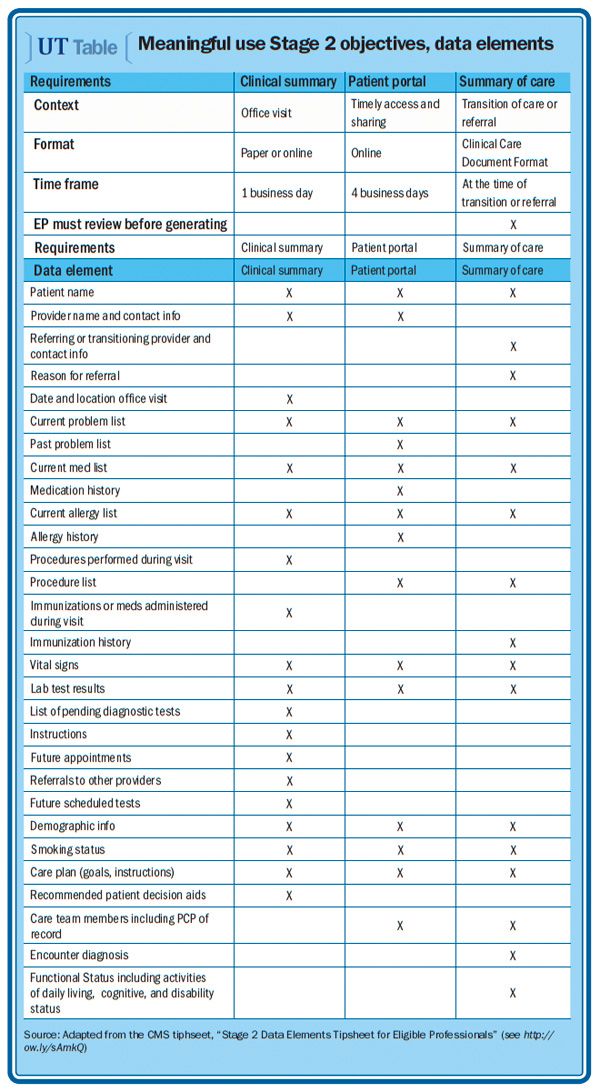Article
Meaningful use Stage 2 ramps up info sharing
In this article, I will try to clarify the differences among the Stage 2 measures in terms of what is required to fulfill each one.

As of Jan. 1, 2014, the first providers who have demonstrated “meaningful use” under Stage 1 of the Electronic Health Record Incentive Program for a period of 2 or 3 years will move into Stage 2. This marks the second phase of the meaningful use incentive program, which the Centers for Medicare & Medicaid Services outlined in a “final rule” published in August 2012.
In late 2012, I published a pair of articles outlining some of the ways Stage 2 differs from Stage 1. In this article, I will try to clarify the differences among the Stage 2 measures in terms of what is required to fulfill each one. For a very helpful reference on the subject, see CMS’s “Stage 2 Data Elements Tipsheet for Eligible Professionals.”
Understanding Stage 2’s nuances
As of this writing, many EHR vendors still have not obtained 2014 certification for their products (a requirement for Stage 1 or 2 attestation in 2014). Since CMS only requires a 90-day attestation period in 2014, those vendors and their physician customers have a few months to implement certified EHRs. Nevertheless, urologists and others are digging into the details of Stage 2 to fully understand some of the nuances.
Stage 2 of meaningful use includes several objectives that require sharing information with another party. Three of these objectives-clinical summaries, patient electronic access (patient portals), and summaries of care-come with specific data elements needed to meet them. While some of the required data elements are shared among the objectives, others are unique to each objective.
Clinical summary
The clinical summary objective contains information pertinent to a specific office visit, and in order to meet the Stage 2 measure must be provided to patients within 1 business day of their visit for at least 50% of the eligible professional’s (EP) qualifying office visits. The information may be in paper or electronic format and is targeted toward the patient. The data elements include items that pertain to the office visit and as of the date the summary is provided (table).

Patient electronic access
A separate Stage 2 objective and measure deals with providing patients the ability to electronically view, download, or transmit (to a third party) their health information. In most cases, this access is granted through an integrated or modular (but certified) “patient portal.” In order to meet the Stage 2 measure, the EP must make the information available to more than 50% of unique patients within 4 business days after the information is available to the EP. Also, EPs are required to track that at least 5% of patients access the information. The data elements for this objective are centered on discrete elements of the patient’s health history, as shown in the table.
Summary of care
A third Stage 2 objective requires that EPs provide a summary of care when a patient is transitioned or referred to another care provider. There are actually three separate Stage 2 measures related to the summary of care: The first requires a summary of care for more than 50% of transitions or referrals; the second requires documenting the summary was provided electronically to a recipient or an exchange; and the third requires documenting that the summary can be transmitted to either a different EHR than the sending EHR or to a CMS-designated test EHR. The data elements for this objective are centered on sending an accurate and standard record of the patient’s health history and current status to the receiving care provider, as outlined in the table. The format of the summary of care record must conform to an electronic standard (such as Consolidated-Clinical Document Architecture).
Bottom line: The EHR incentive programs can be confusing, especially as providers move from one stage of meaningful use to the next. Stage 2 meaningful use attestation raises the bar for eligible professionals to continue to receive payments, and a detailed command of the program is required. The overlap in some of the measures and data elements is best considered in terms of the actual objective, the format of the information, and the audience for the information. For additional reading, I highly recommend bookmarking the Stage 2 educational resources provided by CMS at http://ow.ly/sAmpT.UT
Subscribe to Urology Times to get monthly news from the leading news source for urologists.





